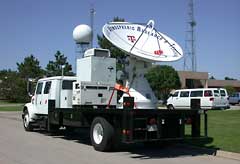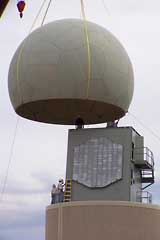Weather radar highlights of NSSL's first 40 years
...continued

The SMART-R Program is a collaborative research program involving four major weather research institutions: The National Severe Storms Laboratory, Norman, Oklahoma, Texas A&M University, College Station, Texas, Texas Tech University, Lubbock Texas, The University of Oklahoma, Norman, Oklahoma.

Installation of the dome on the new Phased Array Radar at the National Severe Storms Lab in Norman, Okla. Participants include NOAA's National Severe Storms Laboratory and National Weather Service Radar Operations Center, Lockheed Martin, U.S. Navy, University of Oklahoma's School of Meteorology and School of Electrical and Computer Engineering, Oklahoma State Regents for Higher Education, the Federal Aviation Administration, and Basic Commerce and Industries.
Mobile Doppler Research Radar
Moving radar technology in a different direction, NSSL (in partnership with the University of Oklahoma, Texas A&M and Texas Tech) developed and are using Shared Mobile Atmospheric Research and Teaching Radars (also known as "SMART-Radars"). SMART-Radars are mobile Doppler radars that can be placed in position as a storm is developing rather waiting for storms to occur within range of stationary radar systems. Two SMART-R’s have already been used to study tornadoes, hurricanes and other weather phenomena across the country.
Phased-Array Radar
NSSL (with the help of its partners, the Navy, Federal Aviation Administration, University of Oklahoma, Oklahoma State Board of Regents, National Weather Service, Lockheed Martin and Basic Commerce Industries) is now leading radar technology into the future with a facility dedicated to phased array radar research and testing in Norman, Okla. Phased array radar uses electronically controlled multiple beams and frequencies on a flat plate antenna (instead of a parabolic or bowl-shaped antenna), which reduces the scan time of weather systems from five to six minutes for NEXRAD radar to only one minute. Phased array radar can also scan the atmosphere at lower levels more effectively and has the capability to quickly re-scan areas with the most severe weather — potentially increasing forecasters' warning lead times. Data gathered from phased array radar will also be used to initialize computer models and improve forecasts. It is expected to take 10-15 years to move from research and development to technology transfer and deployment. Through ingenuity and creativity spanning 40 years, NSSL engineers and scientists have taken technology to the edge. From the original WSR-57 research project to Doppler radar, NEXRAD, and now polarized and phased array radars, NSSL's radar research has truly changed the face of weather.